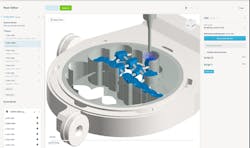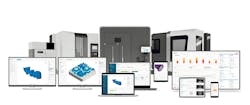It can be difficult to make software seem novel or unique. Today most manufacturing organizations prefer to highlight their ‘digitalization’ efforts – putting the focus on speed and synchronization, rather than on how digitalized data is collected and shared. And mar-comm experts advise those organizations to emphasize how their technologies are ‘disruptive’, rather than how their discrete activities are coordinated.
Those trends were paused, at least, in March when software developer Oqton and energy group Baker Hughes reported their technical and commercial software development agreement. They intend “to develop an industrial digital ecosystem that will transform how manufacturers bring their products to market in highly regulated industries such as energy, aerospace, and healthcare.”
Oqton is an outlier among software developers. Its digitalization strategy is built with production processes at the foundation, then upward and outward to the planned ‘ecosystem’. To date, Oqton has defined digital ecosystems that optimize additive production, 3D scanning, and robotic welding.
“The solution is intended to accelerate the design and production of additively manufactured parts across the entire manufacturing workflow to increase efficiency and facilitate regulatory compliance,” according to the new partners’ announcement.
The reference there is to additive manufacturing, not simply because the oil-and-gas tooling and equipment provider wants AM to expedite the availability of critical parts, but because Oqton is a software company operating as an independent subsidiary of 3D Systems, the developer of additive manufacturing processes, materials, and printers.
As Oqton senior vice president and general manager Dr. Ben Schrauwen described in a lengthy interview in late 2022, the software is for “not only 3D printing”: it aims to project the overall design-to-print efficiency of AM and ensure an “end-to-end manufacturing solution all the way from design to build preparation, simulation, quality control, … like manufacturing execution.”
Considering software’s role
For most manufacturers, the organizational role for software is not much of a discussion: Manufacturers evaluate different developers, and choose a software platform based on the normal factors – applicability, scalability, cost, etc.Different software developers emphasize particular functions for their ‘solutions’, depending on the application: e.g., CAD for designing parts, simulation for planning production sequences, and CAM for programming CNC machines. But those selections managing discrete, sequential tasks are not necessarily operating in coordination. And, even if they are working in synch, this is only one line of activity for the manufacturer in question. Anyone working in manufacturing now will recognize that software has a much wider role.
Schrauwen, once a professor of machine-learning and robotics, anticipated such a wider role when he established his first software firm more than a decade ago. One of his developments – “a software to design and simulate electronics in the browser” – was acquired by Autodesk, which placed Schrauwen in charge of its advanced manufacturing offerings.
“At Autodesk, I was part of this whole strategy to bring CAM – that is, ‘manufacturing engineering’ – closer to CAD,” Schrauwen detailed. He recalled how Autodesk, known for its PLM/CAD technologies, began to acquire CAM companies “like Delcam and TruNest, and Magestic Technologies, and started integrating it into like one holistic solution.”
Other PLM/CAD developers made similar efforts, he noted, expecting that that manufacturers would then select “one solution, one subscription,” he continued. “And that makes the product very sticky.
“But then, when we started talking to customers, it became very apparent that there are all these issues that they are still facing that these developers didn't have answers for,” Schrauwen recounted. He also noted an emerging “labor issue” for manufacturers, involving a diminishing pool of CAM programmers to keep CNC machines operating – and the importance of making that aspect of the industry seem dynamic enough to attract new talent. Product Lifecycle Management (PLM) and similar top-level platforms were just too abstract from the immediate concerns of manufacturers choosing software products.
“And that's why we started Oqton really,” Schrauwen explained, ”with this idea of instead of having manufacturing engineering close to design that it should really be close to production; We should take what's currently in your facility and then design for that. And that's where Oqton came from … Instead of taking CAD and attaching CAM to it, we took an MES system, and then started building automated CAM capabilities from that. And so we applied it in several different industry verticals.”
The first vertical industry sector Oqton went after was 3D printing for dental devices, additive manufacturing for both metal as well as polymer materials. It was a market that was an “early adopter” for additive manufacturing.
“We (Oqton) were very successful in that market,” Schrauwen said. Some customers were taking in AM orders involving 1,000 designs every day from dentists ordering crowns, bridges, removable partial dentures… thousands of files come in per day and the programming of the printing machines and the equipment is fully automated. Previously, those operations had multiple people on staff, “totally overworked doing very repetitive tasks.”
With Oqton’s approach to manufacturing software rooted in CAM functionality, those dental device manufacturers could focus only on work orders that are “very special, or different or new, and all the repetitive tasks can be ‘automated away’,” he explained. He added that his academic experience in machine-learning technology served as a background to developing “specific deep-learning models” that can work with geometric parameters to capture what manufacturing engineers often call ‘intuition’ about object selection, orientation and placement. “We were able to capture that intuition in an algorithm,” the Oqton exec explained.
“Now, we’re going vertical-by-vertical,” Schrauwen elaborated, listing energy, aerospace, and defense sectors as market segments in which Oqton is applying its industrial additive-manufacturing expertise.
“And then we're adding different manufacturing technologies,” he continued. “So initially, it was metal and polymer 3D printing, then we added CNC machining, robotic welding, ... But our plan is then to expand that into other industry verticals.”
The goal is true agility
Schrauwen’s description makes it clear that each of the digital ecosystems Oqton builds will gather and share the data that is specific to the machines and systems of the organization and its vertical market.
Oqton software takes the greatest advantage of the data the organization generates. “A lot of companies have dashboards or data historians, and all the data might be kept and stored somewhere, but it doesn't feed back into engineering functions, to help inform them, to make better decisions,” he observed. Oqton’s goal is “true agility,” he said. “How can we give people in those engineering roles the ability to make those informed decisions?”
Mastering the data-gathering and -application of the additive manufacturing operations is what launched Oqton as a unique MES software offering, optimizing and speeding the particularly demanding task of ‘build preparation’ and ensuring the reliable traceability for each order. Eventually it brought Oqton software to the attention of 3D Systems – which acquired the developer in 2021.
“So, the way it set us up is that Oqton is a separate unit: we have our own marketing, our own sales team,” he detailed. “There's a data firewall between Oqton and the rest of 3D Systems, to ensure that we can keep working in this neutral way, and we can keep working with all our other partners (AM system suppliers) without having to share confidential, customer information. And we sell Oqton to everyone in the market, but 3D Systems bundles it with their machines as a standard offering.”
For Baker Hughes, the Oqton Manufacturing OS will provide factory-floor workflow integration, automation, control, and optimization from part design through final inspection. This will be combined with Baker Hughes’ own proprietary AM functionality developed over the past decade.
Combining Oqton’s autonomous approach to manufacturing and Baker Hughes’ expertise in developing production processes is expected to create “an enhanced additive manufacturing platform for the energy industry,” and lead to additional applications and plug-ins that will become part of the Oqton Manufacturing OS, and open new markets with demanding end-use applications.
“We believe that manufacturing is going through its most significant phase of disruption since the first industrial revolution,” Schrauwen said. “Our mission is to accelerate making autonomous manufacturing accessible to companies of all sizes, enabling the continuous flexibility and adaptability of manufacturing processes.”
About the Author
Robert Brooks
Content Director
Robert Brooks has been a business-to-business reporter, writer, editor, and columnist for more than 20 years, specializing in the primary metal and basic manufacturing industries.

